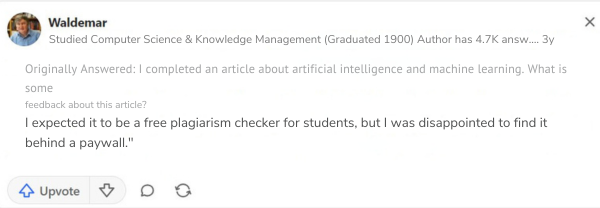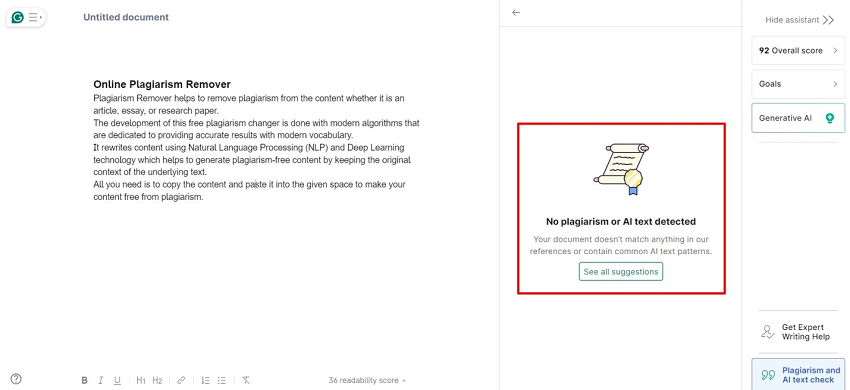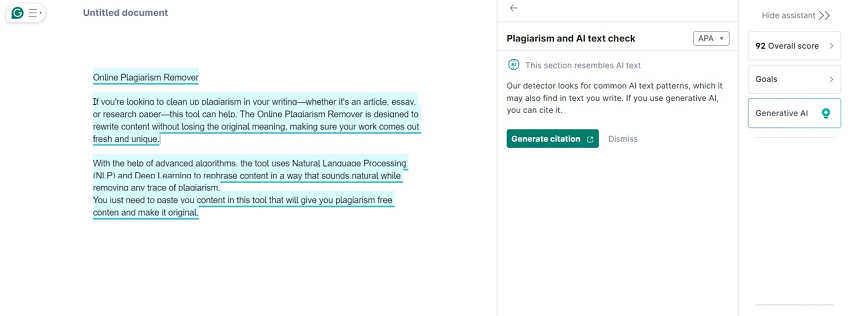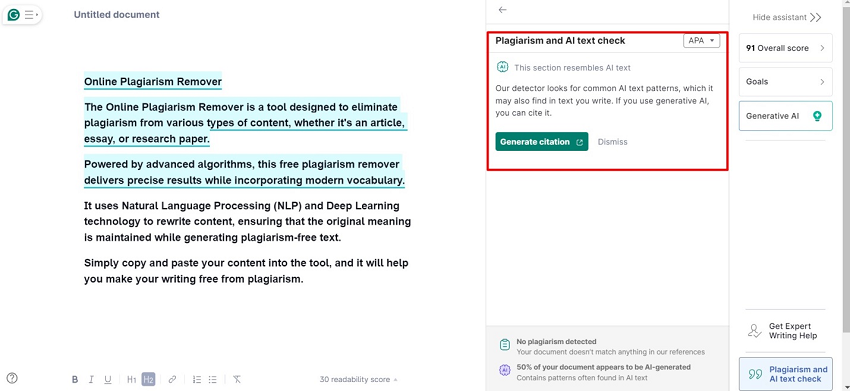Grammarly Plagiarism Checker Reviews: Features, Tests, and How to Bypass It
With the increasing use of digital tools in writing, the Grammarly plagiarism checker has gained considerable attention. Whether you're a student, professional writer, or content creator, ensuring your work is plagiarism-free is essential.
Grammarly's plagiarism detector offers a comprehensive solution, but is it truly effective compared to other tools? This article will explore Grammarly’s how to check for plagiarism in detail, highlighting its key features, user feedback, and a step-by-step testing process. We’ll also discuss how tools like Tenorshare AI Bypass can help bypass detection in certain situations.
Catalogs:
What Is The Grammarly Plagiarism Checker?
The Grammarly plagiarism checker is a feature within the Grammarly writing assistant that scans text for potential plagiarism by comparing it to billions of web pages and academic papers. Unlike many free online plagiarism checkers, Grammarly’s tool integrates seamlessly with its grammar and style suggestions, making it an all-in-one writing assistant for ensuring both originality and quality.
Why Are People Interested in Grammarly’s Plagiarism Checker?
-
Ease of use : Grammarly integrates directly into word processors, making it accessible for anyone writing online.
-
Comprehensive detection : It checks text against a massive database, including academic journals and web content.
-
Time-saving : It scans documents quickly, providing instant results.
-
Multi-purpose functionality : Beyond plagiarism detection, Grammarly also improves grammar, style, and tone, making it a complete tool for writing improvement.
Students, educators, bloggers, and business professionals rely on Grammarly for these capabilities, making it one of the top tools for plagiarism detection.
Key Features
-
Large Database Comparison : Grammarly checks content against over 16 billion web pages and academic publications.
-
Real-Time Detection : Instant feedback is provided as you write, which can save time for urgent projects.
-
Grammar and Plagiarism Integration : Grammarly’s checker operates alongside its grammar and style features, offering a streamlined editing experience.
-
Detailed Plagiarism Reports : After scanning, Grammarly provides a detailed report showing percentages of text matched to external sources.
-
Cross-Platform Accessibility : Available on browsers, apps, and desktops, making it versatile for different users.
Users Reviews and Feedback
To get an accurate representation of how the Grammarly plagiarism checker performs in real-world scenarios, I gathered feedback from social media platforms like Reddit, Twitter, and Quora. Here are three examples:
1. Accurate Detection of Paraphrased Content
A Reddit user shared how they use Grammarly to check research paper for plagiarism before submission. They praised the tool for its accuracy, stating, "Grammarly caught minor similarities that other tools missed, especially in paraphrased content."

2. Overly Sensitive to Common Phrases
On Twitter, one user commented on how Grammarly's plagiarism checker for articles but tends to flag common phrases. "It’s helpful but also annoying when it flags widely-used phrases that aren’t plagiarized at all."

3. Limited Free Access
A Quora user expressed frustration with Grammarly's pricing model, pointing out that the plagiarism checker isn’t part of the free plan. "I expected it to be a free plagiarism checker for students, but I was disappointed to find it behind a paywall."

These reviews highlight the mix of appreciation and critique, emphasizing Grammarly’s effectiveness while also touching on some of its limitations, especially in pricing.
Testing of Grammarly Plagiarism Checker
To evaluate Grammarly’s plagiarism checker, I conducted a test by submitting a 100-word article containing various levels of paraphrased and directly copied content. Here are the testing standards I followed:
-
Test Setup : I tested both paraphrased content and direct quotes from websites and academic journals.
-
Database Scope : I checked if Grammarly accurately compared my text to a vast number of sources, including both recent and old publications.
-
Result Time : I recorded how quickly Grammarly returned the plagiarism report.
Test with Original Text
For this test, I used a 100% unique, self-written piece.
Result : Grammarly returned a 0% plagiarism score, which is expected for original content.
Evaluation : Grammarly correctly identified the original text, showing that it does not falsely flag content without matches in its database. This is essential for writers who want assurance that their unique content won’t be mistakenly marked as plagiarized.

Test with Published Text
I copied a published article from a well-known website and pasted it into Grammarly’s plagiarism checker.
Result : Grammarly detected 100% plagiarism and highlighted the text, identifying the exact source.
Evaluation : This result shows Grammarly's effectiveness at detecting direct plagiarism. Its ability to pinpoint exact sources adds an extra layer of verification for users.

Test with Paraphrased Plagiarized Text
The text was heavily paraphrased from an original source to test Grammarly's ability to detect reworded content.
Result : Grammarly did not flag the text as plagiarized, showing 0% plagiarism.
Evaluation : This test reveals that while Grammarly excels at detecting direct plagiarism, it struggles with detecting heavily paraphrased content. For those looking to bypass detection by rewording text, Grammarly's plagiarism checker might miss such instances.

Test with 50% Plagiarism + 50% Original Text
I combined half of the content from a published article and half of my own original writing.
Result : Grammarly flagged 50% of the text as plagiarized, while the other half remained unflagged.
Evaluation : Grammarly successfully detected the plagiarized portions of the text, making it a reliable tool for catching partial plagiarism. This shows that even mixed content will be accurately flagged, allowing writers to correct any issues before submission.

Pros and Cons
Pros:
-
Accurate for detecting copied content from web pages and academic journals.
-
Integration with grammar tools for a full writing improvement suite.
-
Quick results and detailed reports.
-
Cross-platform accessibility makes it versatile for users on different devices.
Cons:
-
Pricing : The plagiarism checker is only available with a premium subscription.
-
Common phrases can be flagged unnecessarily, leading to over-caution.
-
Limited access for students : Unlike some free plagiarism checkers for students, Grammarly is locked behind a paywall.
Pricing
Grammarly offers different subscription models, and its plagiarism checker is included in the Premium and Business plans:
-
Premium Plan : Starting at $12 per month (annual billing), which includes both plagiarism detection and grammar checking.
-
Business Plan : For teams and organizations, starting at $15 per month per user, with additional features for managing multiple users.
While Grammarly’s plagiarism checker is not free, many users find the added value of grammar and writing assistance to justify the cost.
How to Avoid Being Detected by Grammarly Plagiarism Checker
If you’re looking to avoid being detected by Grammarly’s plagiarism checker, especially for more creative or AI-generated content, Tenorshare AI Bypass can help. This tool alters text in subtle ways, ensuring that it doesn’t get flagged by plagiarism detectors like Grammarly or any other AI plagiarism checker.
Key Benefits of Tenorshare AI Bypass:
-
High success rate in bypassing leading AI detectors, including Originality.ai , Turnitin , and GPTZero .
-
Seamless integration with popular content generation tools, making AI text undetectable.
-
Offers a user-friendly interface with additional humanizing features, making the content flow more naturally.
-
Tenorshare AI Bypass provides humanize AI free for users, allowing a quick and easy way to verify AI content.
With this tool, you can easily pass plagiarism checks while keeping the essence of your content intact.
Conclusion
The Grammarly plagiarism checker is a reliable tool for most users looking to ensure their work is original. It excels in identifying both direct plagiarism and paraphrased content. However, its premium pricing and occasional flagging of common phrases may deter some users.
Tools like Tenorshare AI Bypass can offer creative ways to avoid detection. Whether you're a student, professional, or content creator, Grammarly’s plagiarism checker is a solid choice for plagiarism detection.
FAQs
How accurate is Grammarly’s plagiarism checker?
Grammarly’s plagiarism checker is highly accurate, especially for detecting direct copies from web content and academic journals. However, it may occasionally flag common phrases that aren't technically plagiarized.
Is Grammarly plagiarism checker reliable and safe?
Yes, Grammarly’s plagiarism checker is reliable and safe to use. It only checks your content against public and private databases, ensuring confidentiality.
Is Grammarly plagiarism checker as good as Turnitin?
Grammarly is a strong competitor, but Turnitin vs Grammarly plagiarism checker is a debate often centered on academic use. Turnitin’s database includes more academic papers, while Grammarly focuses more on web-based content.
Does Grammarly’s plagiarism checker actually work?
Yes, it works efficiently, providing quick and detailed plagiarism reports, making it a solid tool for avoiding plagiarism in professional and academic writing.
You Might Also Like
- Chegg Plagiarism Checker: Accuracy, Pricing, and Much More
- Is EasyBib Plagiarism Checker the Right Choice for You? A Detailed Review
- SafeAssign Plagiarism Checker: An In-Depth Review of Its Effectiveness
- No GPT AI Content Detector Review: Features, Pros, Cons and Testing
- Undetectable AI Reviews: Can it Bypass all AI Detectors?

